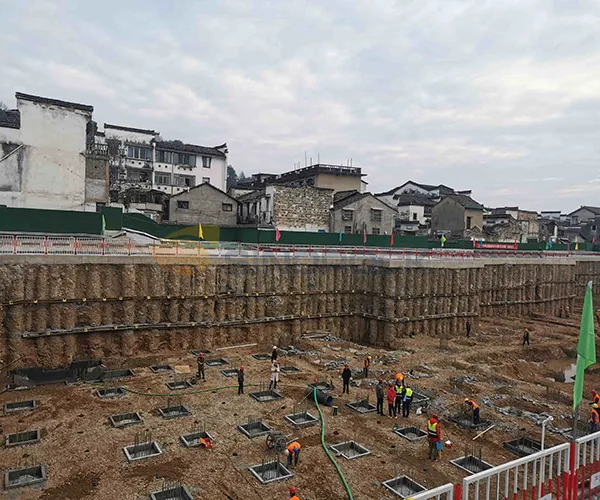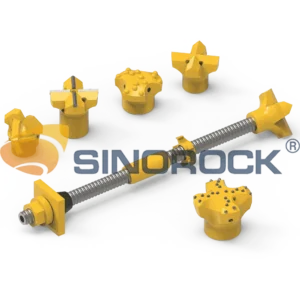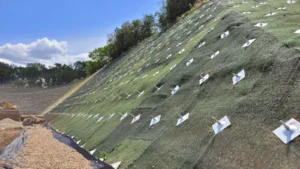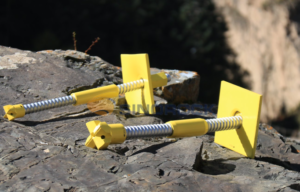Introduction
Soil nails are increasingly being recognized as an efficient, cost-effective, and versatile solution for the stabilization of slopes, excavations, and underground roadways, particularly in the mining industry. Known for their “fast, active, and effective” characteristics, soil nails have seen widespread adoption in coal mine roadway support. As mining operations extend deeper and involve larger cross-sections, the pressure on these roadways increases significantly. This heightened pressure leads to frequent incidents such as roof caving, which are exacerbated by the complex morphology and pressure information of the mine environment. These challenges necessitate continuous improvements in soil nail support technology to ensure the safety and stability of mining operations. This article delves into the factors affecting the quality of soil nail support, analyzing various strategies and technological advancements aimed at optimizing their performance to enhance mine safety and development stability.
1. Control the Material and Performance Index of Soil Nails
Material Selection and Its Impact
The selection of appropriate materials for soil nails is paramount to ensuring their effectiveness in reinforcing roadways. Different materials exhibit varying reinforcement effects due to their distinct tensile strengths and resistance to sliding. For example, high-strength steel and fiberglass composites are commonly used due to their superior mechanical properties and durability. The choice of material should align with the specific conditions of the mining depth and the surrounding rock characteristics to maximize reinforcement effectiveness.
Performance Index Considerations
The performance index of soil nails includes factors such as tensile strength, corrosion resistance, and elasticity. High tensile strength is crucial for supporting large loads and preventing deformation under stress. Corrosion resistance ensures the longevity of soil nails, particularly in environments with high moisture or chemical exposure. Elasticity is important for accommodating slight movements in the surrounding rock without compromising the integrity of the support system. By meticulously selecting materials that meet these performance criteria, engineers can significantly enhance the stability and safety of underground roadways.
2. Appropriate Selection of Soil Nails Torque Force
Relationship Between Torque and Pre-tensioned Stress
The torque applied to soil nails is closely linked to the pre-tensioned stress, which directly affects the reinforcement capability. Research indicates that the friction between the nut and screw of soil nails increases with torque, up to a certain point. When the torque value exceeds 400 N·m, the increase in pre-stressed force becomes relatively slower. Therefore, for practical applications, it is recommended to choose materials that can achieve the desired pre-tensioned stress within a torque range of 300-400 N·m.
Cost and Technical Precision
Balancing cost and technical precision is crucial in selecting the appropriate torque force for soil nails. Over-tightening can lead to material fatigue and premature failure, while under-tightening may result in insufficient support. Utilizing advanced torque measurement tools and adhering to precise installation protocols ensures that soil nails are installed with the optimal force, enhancing their effectiveness and longevity while minimizing costs.

3. Deformation of Soil Nails to Boost Pressure Performance
Mechanism of Pressure Performance
Soil nails are subjected to significant pressure during overload conditions. The elongation of bolts is an effective measure to mitigate deformation and prevent fractures. By incorporating spherical pressure tubes between the nut and tray, the pressure load can be distributed more evenly, allowing the bolt to elongate and absorb additional stress without breaking.
Practical Implementation
In practical terms, the implementation of spherical pressure tubes involves selecting materials that can withstand high compressive forces and integrating them seamlessly into the soil nail assembly. This approach not only enhances the pressure performance but also improves the overall resilience of the support system. Regular inspections and maintenance are necessary to ensure that these components remain effective over time, especially in dynamic mining environments.
4. Strengthening the Rational Match of “The Three Paths”
Importance of Matching Drilling, Rod Body, and Resin Anchoring
For the stability of the soil nail support system, it is essential to ensure the rational matching of drilling, rod body, and resin anchoring. These three components must work together harmoniously to form a robust and effective support structure. Proper matching ensures that the soil nails can withstand the stresses imposed by the surrounding rock and maintain their integrity over time.
Optimal Parameter Values
Achieving the optimal parameter values for each component involves precise calculations and careful selection. For instance, the rebar anchor rod body and hole diameter should be controlled within a range of 6 to 8 mm. During installation, increasing the diameter of the resin anchoring value as much as possible enhances the stability of the soil nails. This meticulous approach to matching parameters ensures that the soil nails provide the best possible support for coal mine rock.
5. Ensuring Soil Nails are Centered and Force Equilibrium
Addressing Fracture Risks
The fracture of soil nails due to excessive stress is a significant concern that affects the quality and reliability of the support system. This issue is often caused by concentrated tensile or shear forces. To mitigate this risk, a high-tech convex angle design for the disc is commonly used to increase the contact area between the nut and tray, thereby distributing the stress more evenly.
Installation Best Practices
During installation, ensuring the uniformity and symmetry of the resin anchoring agent and borehole axis is crucial. This prevents unilateral stress concentration and promotes a balanced force distribution across the soil nail support system. By following best practices and employing advanced design features, the stability and effectiveness of the soil nails can be significantly enhanced, reducing the likelihood of fractures and improving overall safety.
Conclusion
The technology of soil nail support is vital for ensuring the safety and stability of mining operations, particularly in coal mines. By carefully selecting materials, optimizing torque force, enhancing pressure performance, ensuring rational matching of components, and maintaining force equilibrium, the quality of soil nails can be significantly improved. Continuous research and development in this field are essential to address the evolving challenges posed by deeper and more complex mining environments. By implementing these suggestions and countermeasures, the mining industry can enhance roadway stability, reduce the incidence of accidents, and ensure the safety of workers.





